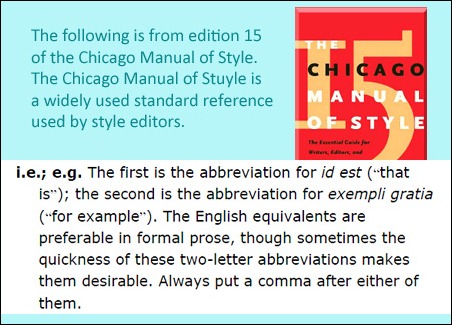Use of e.g. and i.e.
One of the 10 most common errors in punctuation (from “The Ten Sins of Syntax”) is the punctuation used with i.e. and e.g.
I don’t know if it is because of this, or for some other reason(s), but most, if not all, popular publications do not allow the use of i.e. or e.g. You will rarely, if ever, see i.e. or e.g. used in a newspaper, and certainly not in the first 5 to 10 pages of the newspaper where the Flesch-Kincaid Grade Level reading-ease score is lower (typically set to between 7 and 9). For the same reason(s) you will rarely, if ever, come across i.e. or e.g. in popular magazines such as Women’s Weekly, Cosmopolitan, Elle, FHM, GQ, Reader’s Digest, National Geographic, etc. Even novelists rarely ever throw in an i.e. or an e.g.


One reason for this is that, as strange as it may seem, most ‘technical documentation’ is not controlled by a comprehensive and enforced Style Guide, and generally is not review by anyone who might be considered a ‘style editor’.
It is interesting to note that the Microsoft Manual of Style for Technical Publications (Third Edition) does not allow authors creating documentation for Microsoft to use either i.e. or e.g. A quick review of some of the Microsoft user guides and manuals that I have lying around confirm this so they obviously have a style editor or style editing team (more likely) policing the use of the style guide. Note the graphic at left showing excerpts from pages 251 and 277 of the Microsoft Style Guide (which I just happen to have a copy of).
Even so, most people doing technical documentation tend to operate outside of the writing controls that apply to most other ‘documentation’ and publications. Any Style Guide, or Guides, that might apply to people doing technical documentation tend to only be concerned with branding and possibly versioning—although even finding a technical documentation Style Guide that defines the versioning method(s) to be followed is a challenge.
So, if you are going to use i.e. or e.g. what is the accepted syntax?
Firstly, i.e. and e.g. cannot be used to start a sentence, so therefore i.e. will never start with a capital “I” and e.g. will never start with a capital “E”. Just cannot happen; ever.
Secondly, both i.e. and e.g. are always punctuated with full-stops. Always. There are no exceptions to this rule. Using “ie” or “eg” is totally unacceptable.
Thirdly, whenever i.e. or e.g. is followed by other text, which is almost always the case otherwise why use them, then they should be suffixed with a comma. The only time i.e. or e.g. would not be followed by a comma is when they are being used as above—where they are not followed by any related text.
Fourth and last, except in very rare situations, the use of i.e. and e.g. should be enclosed in brackets.
Following are examples of use of the incorrect and correct punctuation for i.e. and e.g.


